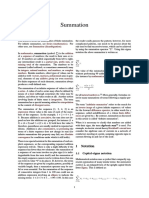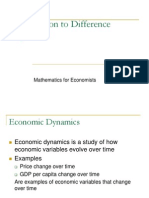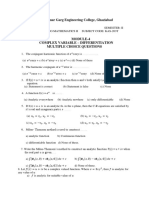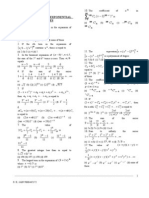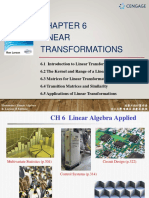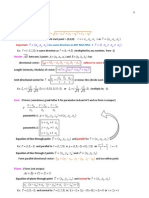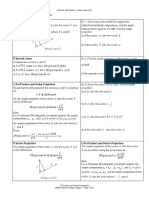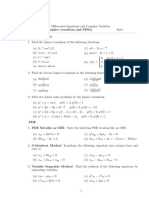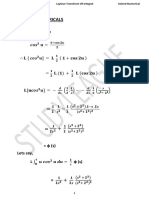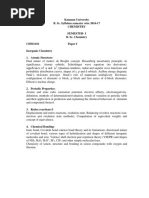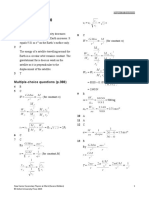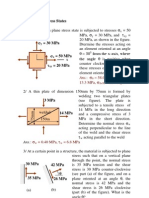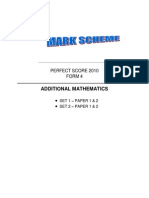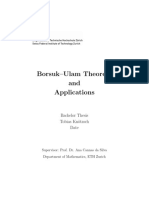Matrices Exercise Solution PDF
Uploaded by
Chai Usajai UsajaiMatrices Exercise Solution PDF
Uploaded by
Chai Usajai UsajaiMatrices (Hints and numerical answers)
1.
1 2 2
A + B = 9 7 8
2 1 3
5 0 2
A B = 3 3 6
0 1 1
2 2 5
A B = 28 6 19
2 0 2
1
3 2
B A = 19 16 27
1 4 3
2 1
8 1
(ii)
2
6
(iii) (8 2)
5 0 2
B A = 3 3 6
0 1 1
4 2
(iv)
3 1
2.
(i)
3.
1 0 1 2 1 2
1 0 1 2 7 4 14 2
(A) = 2
5
+ 3
= 2
5
+ 3
=
0 1 3 1 3 1
0 1 3 1 6 7 3 14
4.
Geometrical interpretation : rotation of a vector by an angle clockwisely and then
clockwisely is the same as rotation of an angle ( + )
an angle
clockwisely. (or rotation of system of axis
anti-closkwisely)
5.
1 n
Let P(n) be the proposition : A n = 0 1
0 0
For P(1),
1 1
A1 = 0 1
0 0
1(1 1)
2
1 =
1
n (n 1)
2
1 1 0
0 1 1
0 0 1
Assume P(k) is true for some k N ,
P(1) is true.
1 k
Ak = 0 1
0 0
k (k 1)
2
For P(k +1) ,
1 k
k +1
k
A = A A = 0 1
0 0
1
1
k (k 1) 1 1 0 1 k + 1 k + k (k 1) 1 k
2
2
k
k +1
1
0 1 1 = 0
= 0 1
0 0 1 0
0 0
0
1
1
1
(k + 1)(k )
2
P(k+1) is true.
By the Principle of Mathematical Induction , P(n) is true n N .
8.
The given simultaneous equations is an inconsistent system.
9.
a b
,
Put X =
c d
3 0 1 0 3 0 1 0
,
,
,
X =
0 3 0 1 0 1 0 3
q(1 p )
2+p
X=
,
(1 m p ) / q 2 p
where p , q R, q 0.
7 4 9
A = 6 3 7
3 2 4
10.
1 1/ 2 0
1
0
A = 0
1 1/ 4 1
12.
4.5
3.5 2
(A + A) = 3 1.5 3.5
1.5
1
2
13.
Consider (B-1A-1) (AB) = (AB) (B-1A-1) = I
14.
Write the infinite series for sin and cos :
14 8 18
6 14
A + A = 12
6
4 8
-1
sin = x
15.
11.
x3
3!
x5
5!
x7
7!
x9
9!
-1
-1
....
-1
2 0
SPS =
0 4
cos = 1
(i)
(I A)2 = I 2A + A2 = I 2A + A = I .
(ii)
A is non-singular A-1 exists
x2
2!
x4
4!
x6
6!
x8
8!
....
I A = A A-1 A = A2 A-1 A (since A is idempotent)
= A (A A-1 ) A = AI A = A A = 0 .
16.
a 2 + bc ab + bd
X2 =
2
ca + dc cd + d
a 2 + bc + pa + q = 0 (1)
(a + d + p ) b = 0
( 2)
We get the equations :
c(a + d + p ) = 0
(3)
d + bc + pd + q = 0 ( 4)
2
(i)
If
a + d + p = 0, then
(ii)
If
a + d + p 0, then b = c = 0. From (1) and (4),
a2 + pa + q = 0
and
Tr(A) = a + d = p
1 1
x = 3 , B =
,
2 1
19.
= 0 , 1, 2 .
20.
= 2r ,
21.
(I A) (I + A) = I A2 = (I + A) (I A) .
3 0
B-1AB =
0 3
, An =
1 3n + 2( 3) n
3n ( 3) n
n
.
3 2[3 ( 3) n ] 2(3n ) + ( 3) n
x = ( t 0 t ) , where t R .
= r2 s2 ,
= 3
|X| = q .
d2 + pd + q = 0. Result follows.
17.
and from (1) + (4),
A2 = A I = 2rA (r2 s2) I .
3 0
1 0
0
1
24.
25.
13
4 1
1
A =
16 19 7
60
2
4 14
26.
(i)
x1 = 5/4
x2 = 3/4
(ii)
x1 = a
x2 = 14 3(a + b)
-1
x 1 = (1 60 )[4h 1 + h 2 + 13h 3 ]
x 2 = (1 60 )[16h 1 19h 2 7 h 3 ]
x 3 = (1 60 )[2h 1 + 7 h 2 + h 3 ]
,
,
x3 = 7/2
x3 = 2(a + b) 10
x4 = b
a, b R .
(iii) inconsistent system .
27.
(i)
x1 = 13/4
x2 = 1/4
(ii)
x1 = 2/3
x2 = 1/3
(iii) x1 = 9/2
x2 = 1/2
x3 = 7/2
(iv) x1 = 1/2
x2 = 1/2
x3 = 3/2
( 3 1 )(a + 1 )( b + 1 )
( 2 1 )(a + 3 )( b + 3 )
(1 3 )(a + 2 )( b + 2 )
x3 =
( 2 1 )(a + 3 )( b + 3 )
28.
x1 =
29.
One solution :
a2 b2
Infinite many solutions :
(a = b c) or
No solution :
other cases.
30.
Non-zero solution if (a = b = c)
or
31.
(c = a = 1 and b 1) or
and
b2 c2 and
c2 a2 .
(b = c a) or
or (a = b = 1 and c 1)
(a = b 1 and c = 1) or
or
(c = a b) or (a = b = c)
(b = c = 1 and a 1)
(b = c 1 and a = 1)
(1)
b=0:
no solution
(2)
a = 1 and b = 1 :
infinite number of solutions
a = 1 and b 1 :
no solution
a = 2 and b = 2 :
infinite number of solutions
a = 2 and b 2 :
no solution
(4)
b0,a1,a2:
unique solution
(i)
x = 3 , y = 1, z = 2 .
(ii)
inconsistent system.
(3)
32.
x2 =
or
(c = a 1 and b = 1) .
You might also like
- G10 - Q2 - PPT - 8 - Angles Formed by Secant and Tangent Lines Copy 2100% (3)G10 - Q2 - PPT - 8 - Angles Formed by Secant and Tangent Lines Copy 231 pages
- Summation: Tal. If Numbers Are Added Sequentially From Left To Right, INo ratings yetSummation: Tal. If Numbers Are Added Sequentially From Left To Right, I6 pages
- Elementary Statistics Triola 11th Edition Test Bank all chapter instant download100% (16)Elementary Statistics Triola 11th Edition Test Bank all chapter instant download31 pages
- Multivariable Calculus Study Guide: AL TEX Version: 1 DisclaimerNo ratings yetMultivariable Calculus Study Guide: AL TEX Version: 1 Disclaimer18 pages
- QUANTUM NOTES: The Linear Algebra Brush Up You Just NeededNo ratings yetQUANTUM NOTES: The Linear Algebra Brush Up You Just Needed30 pages
- Single Variable - Line Integrals - Green's Theorem - Stokes' Theorem - Gauss' TheoremNo ratings yetSingle Variable - Line Integrals - Green's Theorem - Stokes' Theorem - Gauss' Theorem16 pages
- Lecture 9 Introduction To Difference EquationsNo ratings yetLecture 9 Introduction To Difference Equations55 pages
- Set-A Test Series: JEE Main Full Test - 4 Hints & Solutions MathematicsNo ratings yetSet-A Test Series: JEE Main Full Test - 4 Hints & Solutions Mathematics19 pages
- The First Order Quasi-Linear Pdes: 2.1 Characteristic Curves and Integral SurfacesNo ratings yetThe First Order Quasi-Linear Pdes: 2.1 Characteristic Curves and Integral Surfaces12 pages
- Binomial Theorem, Exponential and Logarithmic Series: TH THNo ratings yetBinomial Theorem, Exponential and Logarithmic Series: TH TH4 pages
- Section 4.4 Non-Homogeneous Heat EquationNo ratings yetSection 4.4 Non-Homogeneous Heat Equation6 pages
- Application of Linear Transformation in Computer Graphics PDFNo ratings yetApplication of Linear Transformation in Computer Graphics PDF103 pages
- Lecture 9 (Polar Coordinates and Polar Curves)No ratings yetLecture 9 (Polar Coordinates and Polar Curves)229 pages
- AP Calculus Ab and BC Prerequisite SkillsNo ratings yetAP Calculus Ab and BC Prerequisite Skills12 pages
- Applied Mathematics I (Math 1041) Worksheet INo ratings yetApplied Mathematics I (Math 1041) Worksheet I2 pages
- Relativistic Electromagnetism: 6.1 Four-VectorsNo ratings yetRelativistic Electromagnetism: 6.1 Four-Vectors15 pages
- B.SC - Semester Chemistry - Syllabus ToNo ratings yetB.SC - Semester Chemistry - Syllabus To23 pages
- Introductory Applications of Partial Differential Equations: With Emphasis on Wave Propagation and DiffusionFrom EverandIntroductory Applications of Partial Differential Equations: With Emphasis on Wave Propagation and DiffusionNo ratings yet
- CJC JC 2 H2 Maths 2011 Mid Year Exam SolutionsNo ratings yetCJC JC 2 H2 Maths 2011 Mid Year Exam Solutions14 pages
- Mathtoday Files Wordpress Com 2012 05 Math PiNo ratings yetMathtoday Files Wordpress Com 2012 05 Math Pi99 pages
- Purple Comet: Middle School Problems 2013No ratings yetPurple Comet: Middle School Problems 20135 pages
- Selina Solutions Concise Physics Class 10 Chapter 1 Force0% (1)Selina Solutions Concise Physics Class 10 Chapter 1 Force34 pages
- Assignment 05 Motion in 1D Physics Yakeen 2-0-2024 MR Sir 1No ratings yetAssignment 05 Motion in 1D Physics Yakeen 2-0-2024 MR Sir 12 pages
- Revision Exercise 10: Concept Traps (p.388)No ratings yetRevision Exercise 10: Concept Traps (p.388)8 pages
- 02 Robotics 19MTE Representation of FramesNo ratings yet02 Robotics 19MTE Representation of Frames15 pages
- Instant Access to Hellenic Polytheism Household Worship 1st Edition Christos Panopoulos ebook Full Chapters100% (5)Instant Access to Hellenic Polytheism Household Worship 1st Edition Christos Panopoulos ebook Full Chapters61 pages
- Aerial Robotics Lecture 3B Supplemental - 4 Supplementary Material - Linearization of Quadrotor Equations of MotionNo ratings yetAerial Robotics Lecture 3B Supplemental - 4 Supplementary Material - Linearization of Quadrotor Equations of Motion6 pages
- Name Name: Answer The Following Questions. Answer The Following Questions100% (1)Name Name: Answer The Following Questions. Answer The Following Questions4 pages
- Add Maths Perfect Score Module Form 4 Marking Scheme Set 1 & Set 2No ratings yetAdd Maths Perfect Score Module Form 4 Marking Scheme Set 1 & Set 219 pages
- Utilizing The Leftover Spaces Under Flyover in Surat City100% (2)Utilizing The Leftover Spaces Under Flyover in Surat City6 pages
- JEE Main Physics Previous Year Questions With Solutions On Rotational DynamicsNo ratings yetJEE Main Physics Previous Year Questions With Solutions On Rotational Dynamics11 pages
- Polyvalence, A Concept For The Sustainable Dwelling: Bernard LeupenNo ratings yetPolyvalence, A Concept For The Sustainable Dwelling: Bernard Leupen9 pages
- E-Infinity Coalgebra Structure On Chain ComplexesNo ratings yetE-Infinity Coalgebra Structure On Chain Complexes5 pages


